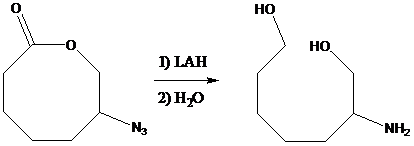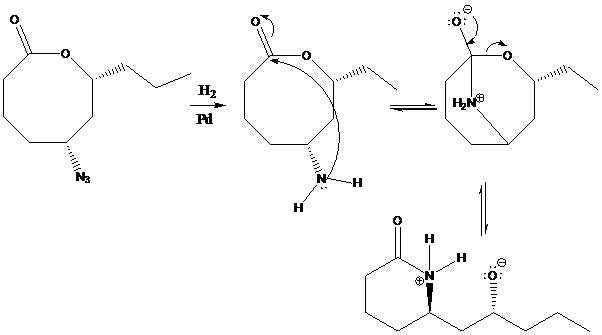
(a)
Interpretation: A structure for the alkaloid halosaline, a reason for not getting the product in the given transformation in one step using LAH and a mechanism for the lactone-to-lactam ring contraction have to be found.
Concept Introduction:
Amides on reduction with lithium aluminum hydride followed by water work-up give the corresponding

To find: Draw a structure for the alkaloid halosaline
Get the formation of lithium salt by reduction
(b)
Interpretation: A structure for the alkaloid halosaline, a reason for not getting the product in the given transformation in one step using LAH and a mechanism for the lactone-to-lactam ring contraction have to be found.
Concept Introduction:
If a compound contains both the azide and lactone ring, lithium aluminum hydride reduces both the groups, azide into the corresponding amine and the lactone ring into the

To find: Get the reason for achieving the given transformation in just one step (rather than two) using LAH to reduce both the azide and the amide in one reaction flask
Get the formation of lithium salt by reduction
(c)
Interpretation: A structure for the alkaloid halosaline, a reason for not getting the product in the given transformation in one step using LAH and a mechanism for the lactone-to-lactam ring contraction have to be found.
Concept Introduction:
The simple lactone-to-lactam transformation occurs due to the driving force of amine nucleophiles. A nucleophile is a chemical species that donates an electron pair to an electrophile to form a
To find: Provide a mechanism for the lactone-to-lactam ring contraction
Provide the nucleophilic attack in the starting material

Want to see the full answer?
Check out a sample textbook solution
Chapter 23 Solutions
ORG.CHEM EBOOK W/BBWILEY PLUS>CUSTOM<
- (c) (4pts) Mechanism: heat (E1) CH3OH + 1.5pts each _E1 _ (1pt) Br CH3OH (d) (4pts) Mechanism: SN1 (1pt) (e) (3pts) 1111 I H 10 Ill!! H LDA THF (solvent) Mechanism: E2 (1pt) NC (f) Bri!!!!! CH3 NaCN (3pts) acetone Mechanism: SN2 (1pt) (SN1) -OCH3 OCH3 1.5pts each 2pts for either product 1pt if incorrect stereochemistry H Br (g) “,、 (3pts) H CH3OH +21 Mechanism: SN2 (1pt) H CH3 2pts 1pt if incorrect stereochemistry H 2pts 1pt if incorrect stereochemistryarrow_forwardA mixture of butyl acrylate and 4'-chloropropiophenone has been taken for proton NMR analysis. Based on this proton NMR, determine the relative percentage of each compound in the mixturearrow_forwardQ5: Label each chiral carbon in the following molecules as R or S. Make sure the stereocenter to which each of your R/S assignments belong is perfectly clear to the grader. (8pts) R OCH 3 CI H S 2pts for each R/S HO R H !!! I OH CI HN CI R Harrow_forward
 ChemistryChemistryISBN:9781305957404Author:Steven S. Zumdahl, Susan A. Zumdahl, Donald J. DeCostePublisher:Cengage Learning
ChemistryChemistryISBN:9781305957404Author:Steven S. Zumdahl, Susan A. Zumdahl, Donald J. DeCostePublisher:Cengage Learning ChemistryChemistryISBN:9781259911156Author:Raymond Chang Dr., Jason Overby ProfessorPublisher:McGraw-Hill Education
ChemistryChemistryISBN:9781259911156Author:Raymond Chang Dr., Jason Overby ProfessorPublisher:McGraw-Hill Education Principles of Instrumental AnalysisChemistryISBN:9781305577213Author:Douglas A. Skoog, F. James Holler, Stanley R. CrouchPublisher:Cengage Learning
Principles of Instrumental AnalysisChemistryISBN:9781305577213Author:Douglas A. Skoog, F. James Holler, Stanley R. CrouchPublisher:Cengage Learning Organic ChemistryChemistryISBN:9780078021558Author:Janice Gorzynski Smith Dr.Publisher:McGraw-Hill Education
Organic ChemistryChemistryISBN:9780078021558Author:Janice Gorzynski Smith Dr.Publisher:McGraw-Hill Education Chemistry: Principles and ReactionsChemistryISBN:9781305079373Author:William L. Masterton, Cecile N. HurleyPublisher:Cengage Learning
Chemistry: Principles and ReactionsChemistryISBN:9781305079373Author:William L. Masterton, Cecile N. HurleyPublisher:Cengage Learning Elementary Principles of Chemical Processes, Bind...ChemistryISBN:9781118431221Author:Richard M. Felder, Ronald W. Rousseau, Lisa G. BullardPublisher:WILEY
Elementary Principles of Chemical Processes, Bind...ChemistryISBN:9781118431221Author:Richard M. Felder, Ronald W. Rousseau, Lisa G. BullardPublisher:WILEY





